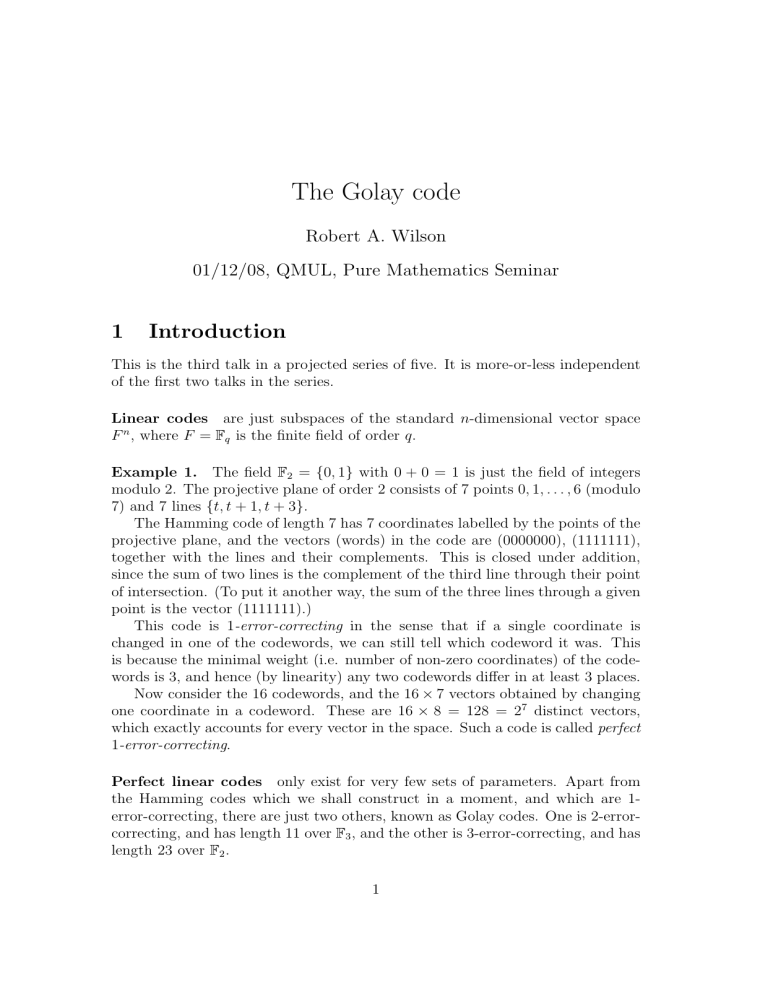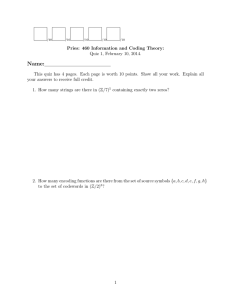
The Golay code
Robert A. Wilson
01/12/08, QMUL, Pure Mathematics Seminar
1
Introduction
This is the third talk in a projected series of five. It is more-or-less independent
of the first two talks in the series.
Linear codes are just subspaces of the standard n-dimensional vector space
F n , where F = Fq is the finite field of order q.
Example 1. The field F2 = {0, 1} with 0 + 0 = 1 is just the field of integers
modulo 2. The projective plane of order 2 consists of 7 points 0, 1, . . . , 6 (modulo
7) and 7 lines {t, t + 1, t + 3}.
The Hamming code of length 7 has 7 coordinates labelled by the points of the
projective plane, and the vectors (words) in the code are (0000000), (1111111),
together with the lines and their complements. This is closed under addition,
since the sum of two lines is the complement of the third line through their point
of intersection. (To put it another way, the sum of the three lines through a given
point is the vector (1111111).)
This code is 1-error-correcting in the sense that if a single coordinate is
changed in one of the codewords, we can still tell which codeword it was. This
is because the minimal weight (i.e. number of non-zero coordinates) of the codewords is 3, and hence (by linearity) any two codewords differ in at least 3 places.
Now consider the 16 codewords, and the 16 × 7 vectors obtained by changing
one coordinate in a codeword. These are 16 × 8 = 128 = 27 distinct vectors,
which exactly accounts for every vector in the space. Such a code is called perfect
1-error-correcting.
Perfect linear codes only exist for very few sets of parameters. Apart from
the Hamming codes which we shall construct in a moment, and which are 1error-correcting, there are just two others, known as Golay codes. One is 2-errorcorrecting, and has length 11 over F3 , and the other is 3-error-correcting, and has
length 23 over F2 .
1
An overall parity check can be added to make a code of length 8 all of whose
words have weight 0, 4, or 8. Indeed, this makes sense for any binary code (i.e.
a code over F2 ), and makes the minimum weight even.
2
Hamming codes
Take a vector space of dimension r over the field F = Fq of order q. This has
q r − 1 non-zero vectors, and therefore (q r − 1)/(q − 1) subspaces of dimension
1. Pick one (non-zero) vector from each such subspace, say v1 , . . . , vn where
n
(q r − 1)/(q − 1). Then the codewords are (λ1 , . . . , λn ) where λi ∈ F satisfy
P=
n
i=1 λi vi = 0.
If we
Pnchoose v1 , . . . , vr to be a basis for the r-space, then we can express any
vector i=r+1 λi vi in terms of the basis, and so get a unique codeword (λ1 , . . . , λn )
completing this. In other words the code has dimension n −r. Its minimal weight
is 3, since any vector λvi + µvj is a scalar multiple of some vk .
It is perfect because it has q n−r codewords, and each has (q − 1)n neighbours,
making altogether (1 + (q − 1)n)q n−r = q n vectors, which exactly cover the whole
space.
Example 2. The field of order 4 is F = F4 = {0, 1, ω, ω}, where 1 + ω = ω and
ω 2 = ω. Take r = 2 and v1 = (0, 1), v2 = (1, 0), v3 = (1, 1), v4 = (1, ω), v5 =
(1, ω) (excuse the eccentric ordering). Then the Hamming code has dimension 3
and is spanned by the vectors
(1, 0, 0, 1, 1)
(0, 1, 0, ω, ω)
(0, 0, 1, ω, ω)
3
The hexacode
Overall parity checks only make sense for binary Hamming codes in general, but
something very special happens with this particular code: we can add a further
coordinate in such a way that all the weights of the codewords are even.
(1; 1, 0, 0, 1, 1)
(1; 0, 1, 0, ω, ω)
(1; 0, 0, 1, ω, ω)
This code is called the hexacode. It is self-dual in the sense that with respect
to the natural (unitary) inner product all its vectors are perpendicular to each
other. It is quite easy to write down all its vectors, and discover that its weight
distribution is 01 445 618 . That is it has 45 vectors of weight 4 and 18 of weight 6.
2
The automorphism group of the hexacode contains the automorphism group
of the Hamming code, which is GL2 (4) ∼
= C3 × A5 . But it is also transitive on
the 6 coordinates, so has order 1080. It is in fact a triple cover 3. A6 of A6 .
4
The Golay code
There are many ways of making the Golay code(s). I’ll describe just one. Adding
an overall parity check to the perfect code gives one of length 24, in which the
minimal weight is 8 instead of 7. This is the code I shall construct.
Put the 24 coordinates in a 6 × 4 array, with the 6 columns labelled by the
coordinates 0, 1, 2, 3, 4, 5 of the hexacode, and the 4 columns labelled by the four
elements of F4 . Now the 24 coordinates lie in F2 and satisfy 12 independent linear
conditions, as follows:
• The parity of all the columns equals the parity of the top row. (6 conditions)
• The sums over each column give a hexacode word. Equivalently, these sums
give a word which is perpendicular to all hexacode words. Equivalently,
perpendicular to six hexacode words forming an F2 -basis. (6 conditions)
In effect, the first column is arbitrary (16 choices), then the second and third
columns have to have the same parity (8×8 choices), at which point the hexacode
word is uniquely determined. Then the fourth and fifth columns are determined
up to complementation (2 × 2 choices) and the last column is determined by the
parity condition. In any case, the Golay code has 212 words.
It is linear because it is defined by linear conditions. It is also self-dual: this
follows easily from the fact that the hexacode is self-dual. Or if you doubt this,
check it on a basis instead:
• Take six vectors of shape one column plus (i.e. symmetric difference) the
top row.
• Take six vectors of shape the top row plus a hexacode word (i.e. 6 such
words forming an F2 -basis of the hexacode).
The weight distribution of the Golay code is 01 8759 122576 16759 241 . To prove
this, first observe that (124 ) is in the code. We can find the following words of
weight 8:
• Two columns: 15 of these;
• One column plus a hexacode word: 6 × 64 = 384 of these;
• The top row plus a hexacode word of weight 4, plus an even number of
these four columns: 45 × 8 = 360 of these.
3
The words of weight 16 are the complements of these, and we find the following
words of weight 12:
• A hexacode word plus 3 columns: 64 × 20 = 1280 of these;
• The top row plus a hexacode word of weight 8, plus an even number of
columns: 18 × 32 = 576 of these;
• The top row plus a hexacode word of weight 4, plus an even number of
columns including one of the other two columns: 45 × 8 × 2 = 720 of these.
Since we have already found 212 codewords, these are all.
The unique linear perfect 3-error-correcting code is obtained by deleting one coordinate from this. It still has dimension 12 of course, and weight
distribution 01 7253 8506 111288 121288 15506 16253 231 .
Round each codeword we count
• 1 codeword
• 23 vectors at distance 1
• 23.22/2 = 253 at distance 2
• 23.22.21/3.2.1 = 1771 at distance 3
making 2048 = 211 altogether, thereby neatly accounting for all 212 × 211 = 223
vectors in the space.
The extended code has the following numbers of vectors at various distances:
• 1 codeword
• 24 at distance 1
• 24.23/2 = 276 at distance 2
• 24.23.22/3.2.1 = 2024 at distance 3
• 24.23.22.21/4.3.2 = 10626 at distance 4
In particular, 2325 cosets of the code contain representatives of weight at most 3,
so the remaining 1771 each have 6 representatives of weight 4, since 6 × 1771 =
10626.
Sextets are the corresponding partitions of the 24 points into six 4s. For example the six columns of our diagram (Curtis’s MOG) form such a sextet, since
the sum of two columns lies in the code.
4
The stabiliser of a sextet permutes the six columns as S6 : an A6 from the automorphism group of the hexacode, together with swapping the last two columns
and simultaneously applying the field automorphism.
Fixing all the columns setwise, we still have the additive symmetry of the
hexacode. Therefore the full stabiliser has shape 26 :3S6 .
The full automorphism group of the extended Golay code is transitive on
the sextets (needs to be proved!), and so has order 244823040. It is the simple
Mathieu group M24 .
5



